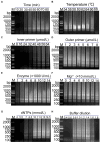Development of a visual detection method of porcine deltacoronavirus using loop-mediated isothermal amplification
- PMID: 39351303
- PMCID: PMC11439776
- DOI: 10.3389/fmicb.2024.1465923
Development of a visual detection method of porcine deltacoronavirus using loop-mediated isothermal amplification
Abstract
The emergence of porcine deltacoronavirus (PDCoV) presents a significant threat to both human and animal health due to its ability to cause highly contagious enteric diseases. This underscores the crucial need for timely and accurate diagnosis to facilitate effective epidemiological investigation and clinical management. This research aimed to establish a visual detection method based on reverse transcription loop-mediated isothermal amplification (RT-LAMP) for PDCoV testing. In this study, six pairs of primers were designed according to the conserved sequences of PDCoV ORF1a/b genes. The primer sets and parameters that affect LAMP reaction were optimized. The visual RT-LAMP method was developed by incorporating methyl red into the optimized reaction system, it exclusively detected PDCoV without cross-reactivity with other viruses and the detection limits for PDCoV could reach 10 copies/μL. In comparison with RT-PCR for testing 132 clinical samples, the relative specificity and sensitivity of the visual RT-LAMP were found to be 99.2 and 100%, respectively, with a concordance rate of 99.2% and a kappa value of 0.959, indicating that the visual RT-LAMP is a reliable method for the application of PDCoV detection in clinical samples.
Keywords: deltacoronavirus; detection; loop-mediated isothermal amplification; porcine; visualization.
Copyright © 2024 Li, Cao, Yuan, Li, Zhou, Wang, Wang and Tian.
Conflict of interest statement
The authors declare that the research was conducted in the absence of any commercial or financial relationships that could be construed as a potential conflict of interest.
Figures




Similar articles
-
A Novel, Cleaved Probe-Based Reverse Transcription Loop-Mediated Isothermal Amplification Method for Specific and Sensitive Detection of Porcine Deltacoronavirus.Front Vet Sci. 2022 Jun 23;9:896416. doi: 10.3389/fvets.2022.896416. eCollection 2022. Front Vet Sci. 2022. PMID: 35812893 Free PMC article.
-
A simple and rapid identification method for newly emerged porcine Deltacoronavirus with loop-mediated isothermal amplification.Biol Res. 2017 Sep 21;50(1):30. doi: 10.1186/s40659-017-0135-6. Biol Res. 2017. PMID: 28934984 Free PMC article.
-
Rapid detection of porcine deltacoronavirus and porcine epidemic diarrhea virus using the duplex recombinase polymerase amplification method.J Virol Methods. 2021 Jun;292:114096. doi: 10.1016/j.jviromet.2021.114096. Epub 2021 Feb 15. J Virol Methods. 2021. PMID: 33600848
-
Development of a triplex RT-RAA-LFA assay for the rapid differential diagnosis of porcine epidemic diarrhea virus, porcine deltacoronavirus and transmissible gastroenteritis virus.Microb Pathog. 2024 Oct;195:106885. doi: 10.1016/j.micpath.2024.106885. Epub 2024 Aug 24. Microb Pathog. 2024. PMID: 39182857
-
Development of a multiplex RT-PCR method for the detection of four porcine enteric coronaviruses.Front Vet Sci. 2022 Nov 8;9:1033864. doi: 10.3389/fvets.2022.1033864. eCollection 2022. Front Vet Sci. 2022. PMID: 36425116 Free PMC article.
Cited by
-
Development of a Paper-Based Microfluidic Chip for Point-of-Care Detection of PEDV.Vet Sci. 2025 Apr 30;12(5):427. doi: 10.3390/vetsci12050427. Vet Sci. 2025. PMID: 40431520 Free PMC article.
References
-
- Chen X., Du C., Zhao Q., Zhao Q., Wan Y., He J., et al. . (2023b). Rapid and visual identification of HIV-1 using reverse transcription loop-mediated isothermal amplification integrated with a gold nanoparticle-based lateral flow assay platform. Front. Microbiol. 14:1230533. doi: 10.3389/fmicb.2023.1230533, PMID: - DOI - PMC - PubMed
-
- Dhama K., Karthik K., Chakraborty S., Tiwari R., Kapoor S., Kumar A., et al. . (2014). Loop-mediated isothermal amplification of DNA (LAMP): a new diagnostic tool lights the world of diagnosis of animal and human pathogens: a review. Pak. J. Biol. Sci. 17, 151–166. doi: 10.3923/pjbs.2014.151.166, PMID: - DOI - PubMed
LinkOut - more resources
Full Text Sources

